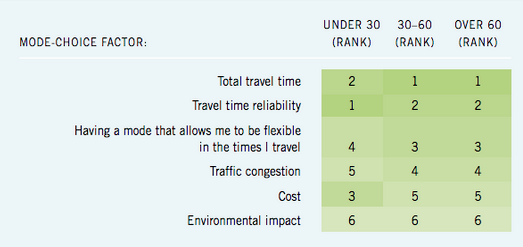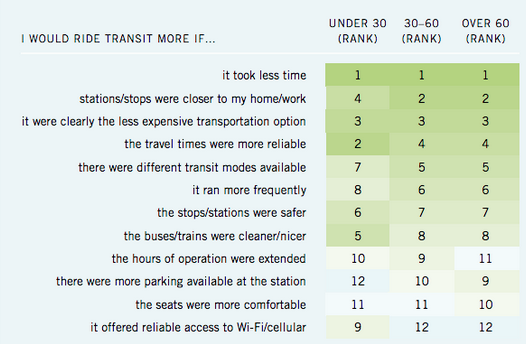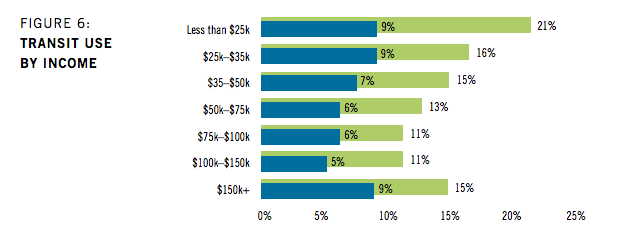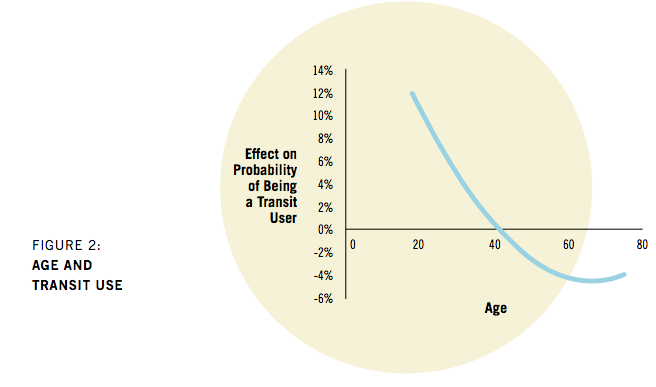A record 10.7 billion rides were taken on public transit in the United States last year. And a national survey of Americans finds that the speed, reliability, and cost, more than any other factors, determine people’s willingness and frequency of use.
The survey of 11,842 adults in 46 Metropolitan Statistical Areas, 60% of whom live in “transit progressive” cities, also found that far more Americans want to live in mixed-use, walkable communities than actually do.
“That’s significant news, not just for planners, but for the real estate industry as well,” wrote David Bragdon, executive director of TransitCenter, a New York-based public policy and advocacy organization, which conducted the poll.
Bragdon asserted that, unlike other public utilities, mass transit is “personal,” and that receptivity to using mass transit is highly dependent on riders’ relationships with it in such areas as efficiency, cleanliness, proximity to stations, and how quickly they get to their destinations.
TransitCenter concluded that transit use is, ultimately, attitudinal. But this inference is a little quirky. Baby boomers who grew up in an era of mass-transit expansion are now far more resistant to using these systems than Millennials who “embrace” mass transit, said the survey.

Graphs courtesy TransitCenter
If you’re an ethnic minority, you are more likely to be a transit rider. Nearly two-fifths of African-Americans polled use mass transit at least once a week, and 22% use it three or four times a week. More than 30% of Hispanics ride buses and trains once a week, and one-fifth use these modes three or four times weekly. In contrast, only 10% of whites ride mass transit weekly, and only 5% use these modes more frequently.
The survey also found correlations between usage and income: high-income Americans are not big riders.
Some perceptions about transit use get debunked: for example, just because you’re a parent doesn’t mean you use transit systems less, although the survey found that parents aged 30 or younger are more positively inclined towards mass transit than older parents.
Students are frequent riders, but higher education is not much of a determining factor about who uses transit systems. That being said, a neighborhood’s employment rate certainly has a positive impact on rider frequency, and the survey found that employees are using transit benefits when their employers offer them.
The top predictor of use, according to the survey, is what kind of neighborhood the person lives in. While most respondents don’t seem to be clamoring to move back into their cities’ core, “many Americans are looking for something different” from their current living environments, Bragdon said. TransitCenter, in fact, sees “widespread demand” for walkable communities, even though most of the respondents aren’t living in these currently.
Related Stories
| Aug 11, 2010
More construction firms likely to perform stimulus-funded work in 2010 as funding expands beyond transportation programs
Stimulus funded infrastructure projects are saving and creating more direct construction jobs than initially estimated, according to a new analysis of federal data released today by the Associated General Contractors of America. The analysis also found that more contractors are likely to perform stimulus funded work this year as work starts on many of the non-transportation projects funded in the initial package.
Museums | Aug 11, 2010
Design guidelines for museums, archives, and art storage facilities
This column diagnoses the three most common moisture challenges with museums, archives, and art storage facilities and provides design guidance on how to avoid them.
| Aug 11, 2010
Broadway-style theater headed to Kentucky
One of Kentucky's largest performing arts venues should open in 2011—that's when construction is expected to wrap up on Eastern Kentucky University's Business & Technology Center for Performing Arts. The 93,000-sf Broadway-caliber theater will seat 2,000 audience members and have a 60×24-foot stage proscenium and a fly loft.
| Aug 11, 2010
Citizenship building in Texas targets LEED Silver
The Department of Homeland Security's new U.S. Citizenship and Immigration Services facility in Irving, Texas, was designed by 4240 Architecture and developed by JDL Castle Corporation. The focal point of the two-story, 56,000-sf building is the double-height, glass-walled Ceremony Room where new citizens take the oath.
| Aug 11, 2010
Carpenters' union helping build its own headquarters
The New England Regional Council of Carpenters headquarters in Dorchester, Mass., is taking shape within a 1940s industrial building. The Building Team of ADD Inc., RDK Engineers, Suffolk Construction, and the carpenters' Joint Apprenticeship Training Committee, is giving the old facility a modern makeover by converting the existing two-story structure into a three-story, 75,000-sf, LEED-certif...
| Aug 11, 2010
Utah research facility reflects Native American architecture
A $130 million research facility is being built at University of Utah's Salt Lake City campus. The James L. Sorenson Molecular Biotechnology Building—a USTAR Innovation Center—is being designed by the Atlanta office of Lord Aeck & Sargent, in association with Salt-Lake City-based Architectural Nexus.
| Aug 11, 2010
San Bernardino health center doubles in size
Temecula, Calif.-based EDGE was awarded the contract for California State University San Bernardino's health center renovation and expansion. The two-phase, $4 million project was designed by RSK Associates, San Francisco, and includes an 11,000-sf, tilt-up concrete expansion—which doubles the size of the facility—and site and infrastructure work.
| Aug 11, 2010
Goettsch Partners wins design competition for Soochow Securities HQ in China
Chicago-based Goettsch Partners has been selected to design the Soochow Securities Headquarters, the new office and stock exchange building for Soochow Securities Co. Ltd. The 21-story, 441,300-sf project includes 344,400 sf of office space, an 86,100-sf stock exchange, classrooms, and underground parking.
| Aug 11, 2010
New hospital expands Idaho healthcare options
Ascension Group Architects, Arlington, Texas, is designing a $150 million replacement hospital for Portneuf Medical Center in Pocatello, Idaho. An existing facility will be renovated as part of the project. The new six-story, 320-000-sf complex will house 187 beds, along with an intensive care unit, a cardiovascular care unit, pediatrics, psychiatry, surgical suites, rehabilitation clinic, and ...











